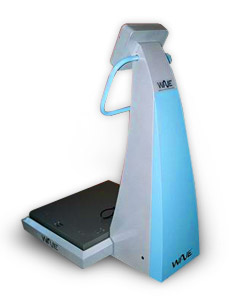 |
|
|
 |
 |
 |
 |
Whole body vibration exercise is backed by years of research, with articles published in peer-reviewed journals. In order to understand the research findings that will continue to be published, it is important to understand the scientific basis behind it. For this reason, vibration exercise is based on accepted physiological responses to exercise, blending physics, engineering, physiology, sports sciences and rehabilitation. |
| |
Scientific principles underlying vibration training: |
• Myotatic Stretch Reflex
• Tonic Vibration Reflex
• Neurological Adaptation to Exercise
• Excitation of the GTO (Golgi Tendon Organ)
• Optimal Recruitment of Motor Units
• Force and power output through increased acceleration
•
Stretch-Shortening-Cycle (SSC) Model
• Effects on the Hormonal System
• Effects on the Circulatory System
• Effect on the skeletal system through Wolff’s Lawal adaptation, shifting the force/velocity curve to the right (faster strength gains)
|
 |
| |
| Useful Downloads & Reference Studies |
| |

 |
Bosco, C., Cardinale, M., Colli, R., Tihanyi, J., von Duvillard, S.P., and Viru, A. The influence of whole body vibration on the mechanical behaviour of skeletal muscle.
This study looked into the effects of vibration exercise on enhancements in the height of the best jump, the mechanical power of the best jump, and the average jumping height during 5 seconds of continuous jumping. Results indicated an increase of 1.6%, 3.3 % and 12% respectively. This study suggests that the effect of vibration treatment elicited fast biological adaptation connected to neural potentiation. |

Cardinale, M. and Bosco, C. The use of vibration as an exercise intervention. Exerc Sport Sci Review 2003; 31(1): 3-7.
This review summarizes the current knowledge on the effects of vibration on human performance and to identify the potential mechanisms that underlie the enhancement of strength and power production. The article goes over the key concepts of 1. neuromuscular adaptation, 2. muscle strength, 3. muscle power, and 4. muscle spindles.

Cardinale, M. and Lim, J. Electromyography activity of vastus lateralis muscle during whole-body vibrations of different frequencies. Journal of Strength and Conditioning Research 2003; 17(3): 621-4.
The aim of this study was to assess the EMG activity of the vastus lateralis muscle during different vibration frequencies (0 Hz, 30-, 40-, and 50-Hz) A basic squat position was held for 60 seconds. The highest EMG readings was found at 30 Hz, suggesting this frequency as the one eliciting the highest reflex response in a half squat position. This study also recommended further studies be done on a larger population, in an attempt to develop individual treatment protocols.

Cardinale, M. and Wakeling, J. Whole body vibration exercise: are vibrations good for you? Br J Sports Med 2005; 39: 585-9.
This study examines the various scientific principles behind vibration exercise. Its recent popularity is due to the combined effects on the neuromuscular and neuroendocrine systems. This review analyses state of the art whole body vibration exercise techniques, suggesting reasons why vibration may be an effective stimulus for human muscles. This review goes over the scientific concepts of the ‘muscle tuning hypothesis’, metabolic effects of vibrations, acute effects of vibration on neuromuscular performance, and chronic effects of vibration on neuromuscular performance.



Mester, J., Kleinöder, H., and Yue, Z. Vibration training: benefits and risks. J Biomech 2006; 39(6):1056-65.
This paper summarizes their previous studies, confirming that vibration training is an effective training method in order to improve maximal strength and flexibility as well as various other factors if the training is properly designed. Other summaries include 1. frequencies used in vibration training should not be lower than 20 Hz, 2. Low amplitude (1-2mm) should be used in vibration training for leisure sports and as the starting point for elite sports, 3. exposure duration for each vibration training should be very short (20-60s), especially when working with high additional loads, and 4. vibration training should be avoided for people with existing coronary disease or hypertension.

Nishihira, Y., Iwasaki, T., Hatta, A., Wasaka, T., Kaneda, T., Kuroiwa, K., Akiyama, S., Kida, T., and Ryol, K.S. Effect of whole body vibration stimulus and voluntary contraction on motoneuron pool. Japan Society of Exercise and Sports Physiology 2002; 83-6.
This study investigated the influence of transient whole body vibration and voluntary contraction on the motorneuron pool. The study shows an increase in the excitability of the alpha motorneuron pool, thereby showing that whole body vibration exercise does indeed have an effect on the central nervous system.

Rittweger, J., Ehrig, J., Just, K., Mutschelknauss, M., Kirsch, K.A., and Felsenberg, D. Oxygen uptake in whole-body vibration exercise: influence of vibration frequency, amplitude, and external load. Int J Sports Med 2002; 23: 428-32.
Vibration exercise is known to increase muscle power. This study found that vibration exercise enhances muscular metabolic power and thus muscle activity.


Warman, G., Humphries, B., and Purton, J. The effects of timing and application of vibration on muscular contractions. Aviat Space Environ Med 2002; 73(2): 119-27.
Significant improvements in muscular strength and activation for concentric isotonic contractions performed during an applied vibration suggest that the optimal timing of a vibratory stimulation would be while the participant is contracting isotonically. However, further research needs to be conducted to establish the exact mechanism behind these improvements. |
 |
| |
| Contact Us » |
|
 |
|
 |
|
 |
|
|
| Copyright ©2006 - WavExercise.com |
|
 |
|
| |
|
 |